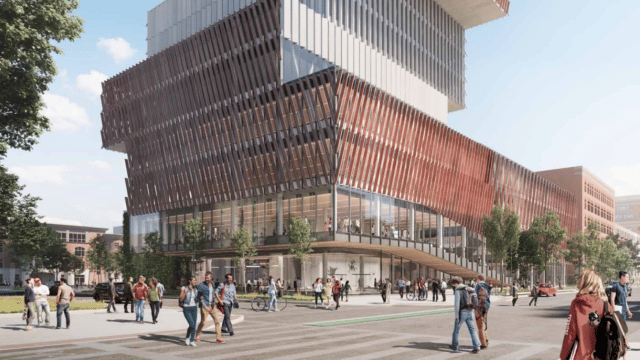Boston University’s Center for Computing and Data Sciences has drawn comparisons to a monumental game of Jenga for its distinctive design, but its larger legacy could be serving as a model for sustainable buildings in an urban setting.
Scheduled to break ground in April, it’s expected to become Boston’s largest building with geothermal heating and cooling. As local and state officials consider building code changes requiring developments to reduce their carbon footprints, the $290 million project will be monitored by the commercial real estate industry to determine if the designs translate to projects with short investment timelines.
“Everybody understands how important carbon reduction is, and as long as you can make the financial case work, there’s a drive to do so,” said Jacob Knowles, director of sustainable design at Boston-based BR+A Consulting Engineers, one of the project team members.
A network of 31 wells drilled to a 1,500-foot depth at the 665 Commonwealth Ave. site will power a geothermal heat pump system supplying all of the 350,000-square-foot tower’s heating and cooling requirements. A triple-glazed exterior will insulate the interior from temperature fluctuations, while a power purchase agreement with a South Dakota wind farm will offset the impact of the entire BU campus on the electric grid.
The building will occupy nearly the entire 0.9-acre site, but BU was able to extend the geothermal wells onto neighboring parcels that it owns, making room for a well field with bore holes spaced approximately 30 feet apart.
“We saw an opportunity to construct a building that would put us on the map in a new way,” said Walt Meissner, BU’s associate vice president for operations. “This became a convergence: an academic program we felt we could make more distinctive, coupled with an opportunity on a site that could work well for us.”
Opportunity for Innovation
Reaching 19 stories by its scheduled completion in 2022, the center reflects BU’s strategy to emphasize the expanding data science programs in its math, statistics and computer science departments. The new home will replace academic spaces in several older buildings including 111 Cummington Mall, a warren of dimly-lit hallways and small offices that Meissner likened to a “rat’s maze.” The new facility will emulate the collaborative space trend sweeping corporate America, with generous natural light and open floor plans.
But the aggressive sustainability designs emerged relatively late in the planning process, Meissner said.

Boston University’s $290 million Center for Computing and Data Sciences building will be Boston’s largest to be heated and cooled by a geothermal system, including 31 wells drilled to a depth of 1,500 feet below Commonwealth Avenue. Image courtesy of KPMB
The university originally hired architect KPMB in 2013 to design a new academic building on the site, previously used as surface parking. The project was put on hold pending completion of two other building projects before moving ahead in 2017, as greenhouse gas emissions reduction was becoming a top priority, Meissner said.
“We saw an opportunity to use a geothermal system and do something innovative. But doing geothermal on an urban site has a lot of challenges,” he said.
Geothermal systems circulate water through pipes buried deep into bedrock to extract heat in cold weather, and transfer heat from the structure back into the ground during the summer.
Finding space for geothermal wells was one of the biggest engineering challenges. The building will occupy nearly the entire 0.9-acre site, but BU was able to extend the geothermal wells onto neighboring parcels that it owns, making room for a well field with bore holes spaced approximately 30 feet apart.
Geothermal systems in rural areas might include hundreds of wells, but the congested city environment required contractors to dig deeper. It took contractors approximately a week per well to drill through bedrock that begins at a depth of 200 feet down to 1,500 feet, Meissner said.
Energy consumption also will be reduced through the installation of exterior louvers that redirect sunlight.
Boston-based construction managers Suffolk will begin mobilizing on the site for excavation work in March and begin vertical construction this fall.
Wind Project Offsets Electric Usage
Construction of the center coincides with BU’s progress on its 2017 climate action plan, which set a goal of campus-wide Net Zero performance by 2040. The report recommended renewable power purchase agreements to offset the university’s energy usage, at an estimated cost of $7.5 million a year.

Steve Adams
After receiving bids on 127 wind and solar projects, the university struck a 15-year deal with ENGIE North America to purchase power from a massive wind farm it’s building in Highmore, South Dakota and resell the power in the Midwest.
Dennis Carlberg, an architect and BU’s sustainability director, said the contract equates to 100 percent of the university’s total electrical usage of 205 million kilowatt-hours annually. Financial terms have not been disclosed.
“Because of the carbon intensity of that grid in South Dakota, we’ll have two to three times the impact on greenhouse gases as if we did it here in New England,” Carlberg said. “The 15-year contract is really causing the [wind] project to happen, because they can take that to the bank and get it financed.”







